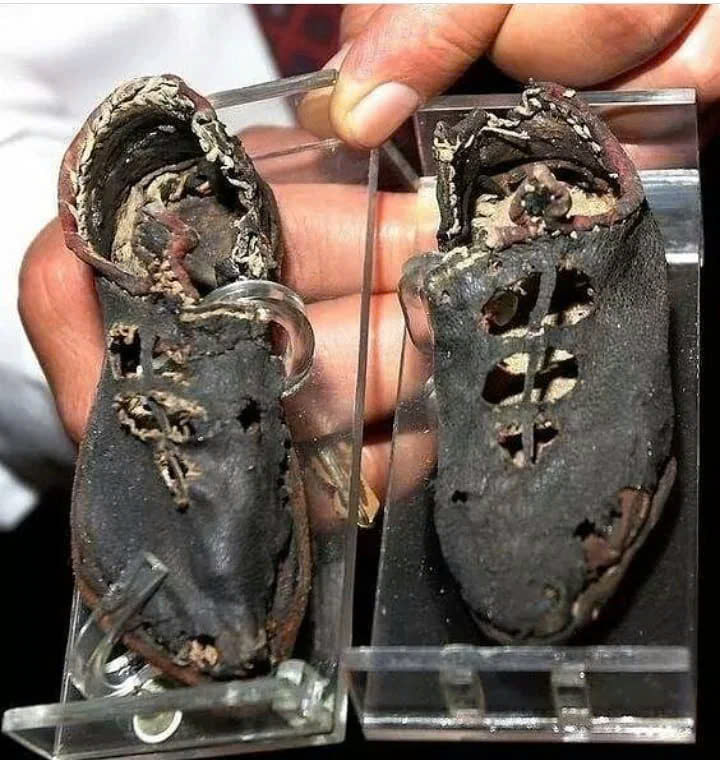Amid the sun-bleached ruins of Palmyra, nestled among crumbling columns and once-grand temples, a discovery the size of a child’s footprint has reignited global fascination with this ancient desert city. Archaeologists recently uncovered a pair of children’s shoes estimated to be over 2,000 years old, remarkably preserved despite the passage of time. This seemingly simple artifact offers a deeply personal window into the daily life of a young child who once walked the streets of Palmyra—an emotional and humanizing contrast to the grandeur and tragedy so often associated with ancient ruins.

Palmyra, once known as Tadmor, was far more than a remote outpost in the desert. Situated strategically around a life-giving oasis in present-day Syria, the city rose to prominence as a bustling hub along the Silk Road—a trade network that connected the distant worlds of the Roman Empire to the Far East. Established as early as the third millennium B.C., Palmyra flourished during the height of Roman influence, becoming a melting pot where East met West. Cultures, ideas, languages, and religions intertwined in this desert city, creating a uniquely vibrant and cosmopolitan society. It was a place where caravans carried silk, spices, and incense, and where people from distant lands mingled in the shade of soaring colonnades.
When most people think of Palmyra, their minds drift to the city’s massive architectural achievements: the majestic Temple of Bel, the grand colonnaded street, the striking funerary towers—all symbols of wealth and power. But these ruins, as awe-inspiring as they are, can overshadow the quieter stories that once animated the city. The discovery of the tiny shoes cuts through the monumental scale of history and offers something more relatable, more tangible. These shoes speak of an individual—a child whose name is lost to history but whose presence lingers through leather and thread. In finding these shoes, we are reminded that ancient cities were not just collections of stone and sculpture but were filled with real people living ordinary lives.
The craftsmanship of the shoes is also telling. Despite their small size, they are finely constructed, suggesting not only skilled artisanship but access to high-quality materials. This supports what historians and archaeologists have long known: that Palmyra was deeply connected to vast trade networks that brought goods and influences from across the known world. The design and stitching hint at techniques from multiple cultures, revealing the deep exchange of knowledge and aesthetics between civilizations. Roman, Persian, and Greco-Roman styles blend subtly within the seams, underscoring Palmyra’s position as a cultural crossroads.
What makes this discovery particularly moving is the way it brings ancient history to life. Often, history is reduced to timelines, battles, rulers, and revolutions. Yet here, in these delicate shoes, lies evidence of something timeless—a child’s presence. Perhaps they ran through the dusty alleys, played under the watchful eyes of market vendors, or walked hand-in-hand with a parent to the city’s vibrant marketplace. These imagined scenes, though speculative, feel grounded in the physical reality of the shoes themselves. They evoke the universal experience of childhood and the enduring bond between parent and child. Whoever made these shoes likely did so with care, perhaps even love, hoping to protect their little one’s feet from the harsh desert ground.
In recent years, Palmyra has faced devastating threats from both natural erosion and human conflict. Much of its architectural heritage has been damaged or destroyed, and the loss is deeply felt within the global archaeological community. However, finds like this pair of children’s shoes serve as powerful reminders that even in the face of destruction, pieces of the past endure. These shoes are more than relics; they are symbols of resilience—of a culture that lived, thrived, and left behind traces that continue to speak to us across millennia.
Artifacts like these allow us to shift our perspective, to see ancient civilizations not only through the lens of politics or empire but through the lives of ordinary people. They remind us that every great city was once filled with laughter, struggle, routine, and love. The grand history of Palmyra, often told through the lens of trade and conquest, becomes more human when viewed through the eyes of a child who once wore these shoes. The city’s bustling streets, once echoing with the sounds of merchants and camels, also carried the soft, quick footsteps of children at play.
This discovery challenges us to consider how we interpret the past. While towering monuments capture our awe, it is often the smallest artifacts that capture our hearts. The shoes make history feel immediate and real, inviting us to step beyond textbook facts and into the lives of those who lived them. They are a bridge, connecting us to people who are long gone but whose experiences, emotions, and relationships were likely not so different from our own.
In closing, the discovery of these ancient shoes is not merely about leather worn by time—it is about the stories they represent. It is about honoring the countless unnamed individuals who built, shaped, and lived within Palmyra’s walls. In the delicate curves of a child’s shoe, we find the enduring power of human connection, the richness of shared culture, and the quiet dignity of everyday life. And perhaps most importantly, we are reminded that the most profound historical insights often come not from grand structures, but from the smallest footprints left behind.





